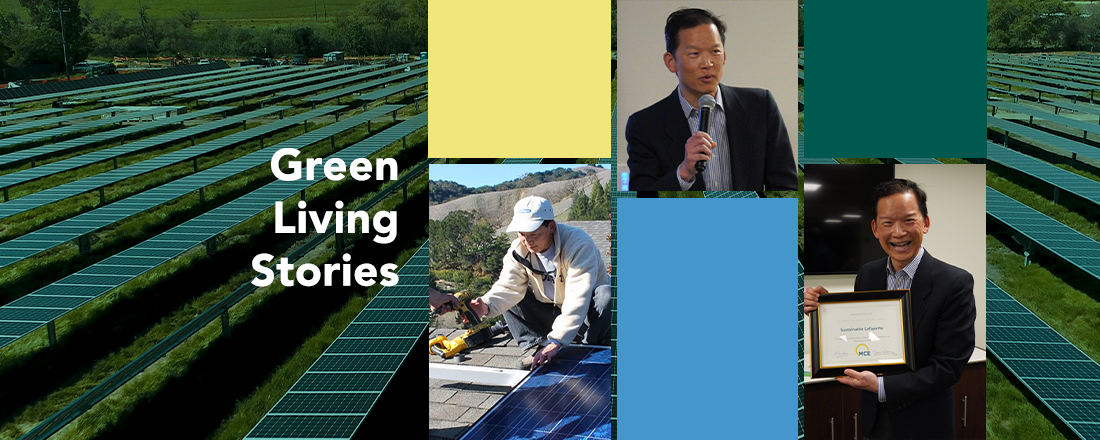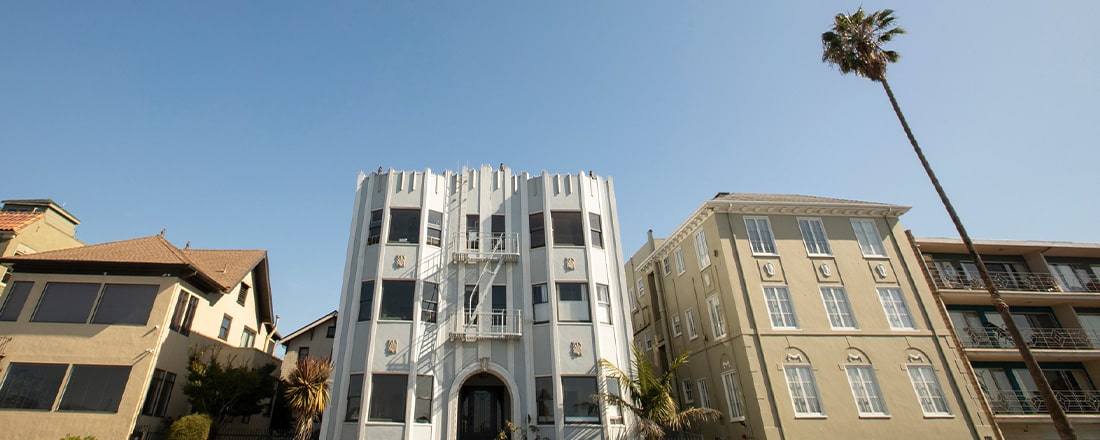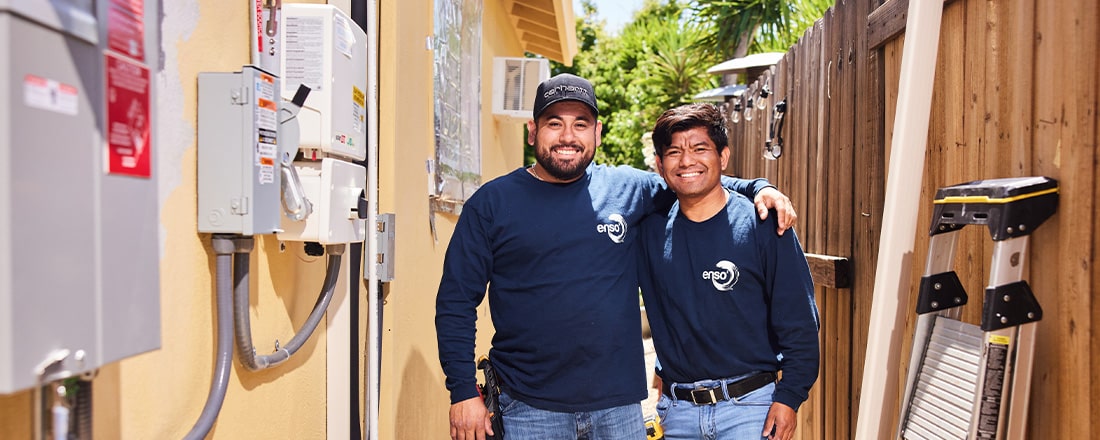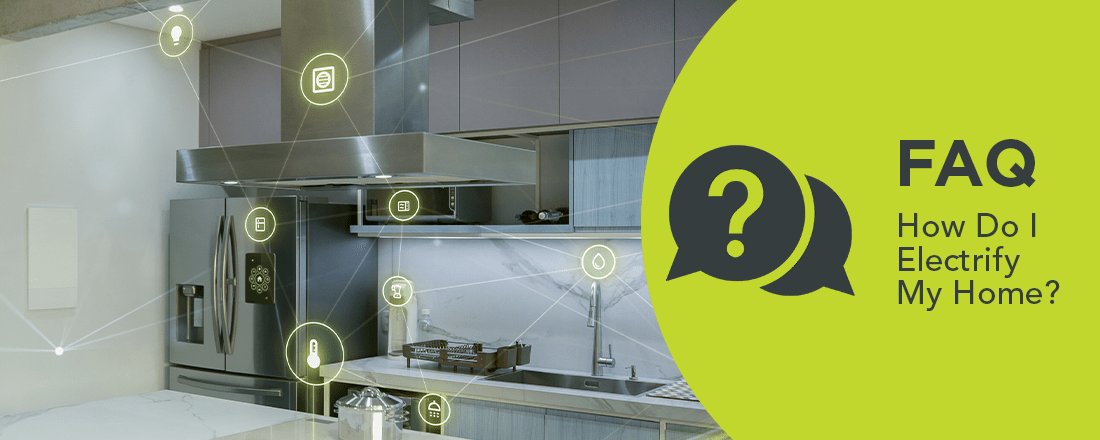Building electrification (or building decarbonization) shifts the energy use in homes and businesses from gas powered appliances to all electric models. Using energy efficient electric appliances – like heat pumps and induction stoves – significantly reduces greenhouse gas emissions, improves indoor air quality, and supports a green energy economy.
How Electrification Benefits Your Community
How Communities Can Achieve an Electrified Building Sector
Adopting reach codes can be a useful tool for communities working toward building electrification. Every three years, the state of California updates its Building Standards Code. Local jurisdictions can choose to adopt the state’s standards or implement reach codes – building codes that “reach” beyond state standards and encourage or require all-electric readiness for new buildings. Reach codes also help cities and towns achieve their environmental goals.
CalGreen is the first statewide green building code to be adopted in the United States. It addresses the five divisions of building construction:
- Planning and design
- Energy efficiency
- Water efficiency and conservation
- Material conservation and resource efficiency
- Environmental quality
Communities across the state, including many MCE member communities, have recently adopted reach codes.
Resources to Help You Take the Next Step
Several rebates, incentives, and educational resources are available from MCE and our partners. For information about residential home electrification incentives visit our Inflation Reduction Act page.
Municipality Resources
Statewide Reach Codes Program – help for municipalities to drive reach code development and adoption
Staff Report (New Construction) (docx) – sample reach code staff report for City Council meetings
Sample Code Facts and Findings (docx) – submitted by Menlo Park and can serve as a model for other communities
County of Marin – online resources for communities looking to electrify
PCE’s Design Guidelines for Home Electrification (pdf) – guide for contractors, DIYers, and policymakers
Builder & Contractor Resources
MCE’s Workforce Education & Training program – no-cost matching with paid, pre-qualified workers
MCE’s Heat Pump Water Heater rebates – $1,000 per unit rebates for contractors
PCE’s Design Guidelines for Home Electrification (pdf) – guide for contractors, DIYers, and policymakers
CalGreen residential checklist (pdf) – tool for builders in communities that have set higher standards for sustainable building goals
California Energy Commission’s BUILD Program – incentives and assistance to new all-electric low-income residential buildings
Contra Costa County – resources for the new construction all-electric ordinance requirement
The Switch Is On – resources for clean energy home installations
FAQ
The electric grid is a network of technologies across a geographic area that bring electricity to your home or business. This includes:
- Generation, which is the source of the power. This is the component of the grid that MCE is responsible for as an energy provider in our service area. MCE buys and helps build clean energy sources to help serve customer’s energy demand.
- Transmission, which are large high voltage power lines that carry power over long distances. PG&E is responsible for the maintenance and upkeep of these lines.
- Distribution, which are the smaller, lower voltage lines that you sometimes see around your neighborhood. PG&E is also responsible for the maintenance and upkeep of distribution lines.
- Other parts of the grid include substations, which convert high voltage power from transmission to lower voltages that can be accepted by the distribution system, and transformers, which convert power, typically at the distribution level, to an even lower voltage so that it can safely reach homes and businesses.
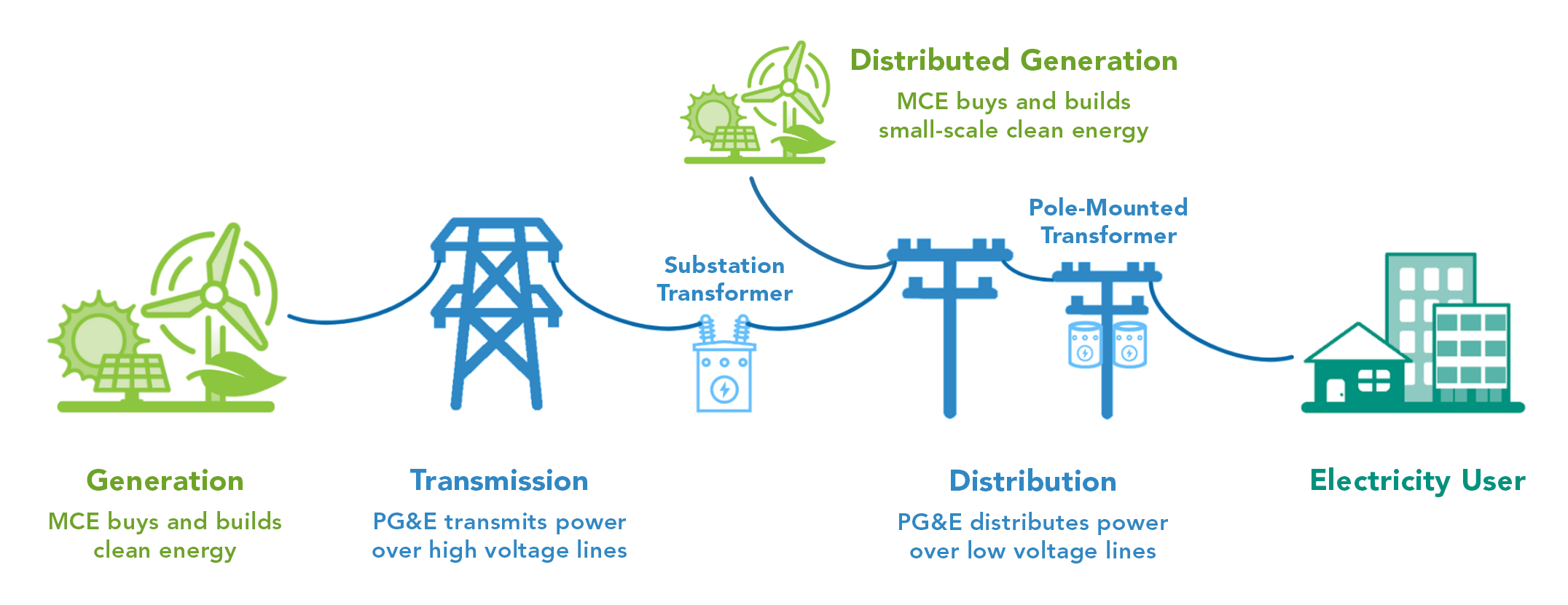
Ensuring that the grid can reliably serve customers involves many stakeholders. One agency that plays a key role in this is the California Independent Systems Operator, or California ISO. California ISO is charged with ensuring the safe and reliable transportation of electricity on the power grid. As the impartial grid operator, it has no financial interest in any individual segment, ensuring fair and transparent access to the transmission network and market transactions.
Yes, however, infrastructure upgrades and new technologies will be necessary.
Electric utilities forecast customer energy demand years in advance. Because reach codes typically apply to new construction and, in some cases, renovations of existing building, the change is gradual and allows ample time for forecasting trends in electrification. Similarly, there is a general consensus that utilities can generate enough power to support the growing demand for electric vehicle charging needs.
MCE’s Operational Integrated Resource Plan (pdf) covers trends in energy procurement over the next 10 years, and as an agency, we are already planning for long term electrification trends throughout our service area.
One challenge to electrification is the need for grid infrastructure upgrades. A study from UC Berkeley, funded with support from the California Energy Commission, found that a number of upgrades to PG&E’s transmission and distribution network in the next decade will be necessary to support electric capacity required for aggressive electrification goals. Berkeley recommends that utilities reduce the uncertainty of future capacity upgrades by updating modeling processes to better capture energy needs on specific distribution circuits.
Despite potential infrastructure challenges, there are several strategies that communities and utilities alike can employ to support a healthy electric grid. The same Berkeley study concluded that investment in “non-wires alternatives” like demand response and storage can reduce the required volume of infrastructure upgrade projects.
MCE is already investing heavily in these technologies and programs. MCE’s FLEXMarket programs incentivize customers to shift energy usage away from peak hours in the summer and during demand response events when the grid is most constrained.
No. Typically electric reach codes only apply to new construction and will not affect residents or businesses who already have gas appliances. We do, however, encourage switching to electric appliances. Gas appliances, such as stoves and wall furnaces contribute to poor indoor air quality, which can be harmful to children, pets and people with asthma or other breathing challenges. Try using an induction cooktop to test the advanced technology in cooking, now recommended by leading chefs.
- Rebates and Incentives – To offset the initial cost of electric appliances, MCE and our partners offer a number of rebates and incentives. Interested in purchasing a new heat pump, induction stove, or furnace? MCE and the Bay Area Regional Energy Network have rebates that can help.
- Energy Efficiency – New appliances are becoming more energy efficient each year. Older refrigerators, for example, use 3x more energy than new, energy efficient modes. By using less energy through energy efficient appliances, customers can save on monthly bills.
- Gas Rates – The price of natural gas in California continues to rise, with early 2023 having some of the highest consumer costs on record. Going all electric eliminates the need for natural gas in the home and could help lower utility bills in the long term.
Today’s modern electric appliances are more efficient than natural gas, so they use less energy and therefore cost less to operate. Initial capital costs can be higher for these products, but when you factor in rebates and incentives available and lower costs over the life of the equipment, all-electric is generally more cost effective.
When purchasing energy for customers, MCE is subject to the same market conditions as any energy provider. The commodity chain – the process of energy production, distribution, and consumption – is subject to market volatility based on customer demand for both renewable and fossil fuel sources of energy. This makes it challenging to say that renewable energy will always be less expensive in the short term, however, trends within the energy industry suggest that renewables will greatly outpace fossil fuels in terms of cost effectiveness into the future.
Recent studies endorsed by the United Nations have shown that, amid climbing fossil fuel prices, investments in renewables in 2021 saved $55 billion in global energy generation costs in 2022.
Additionally, as the California electric grid continues to evolve, MCE and other electricity providers are investing heavily in distributed energy resources. Because of investments in energy storage, it is expected that California’s energy storage portfolio could yield net grid benefits of up to $1.6 billion a year by 2032. Investments in battery storage and other new technologies represent a climate friendly and efficient way for MCE to manage supply and demand for our customers in a cost competitive way.
Lastly, the cost of failing to transition to renewable energy is too high. Climate change remains a serious threat, and widespread adoption of renewable energy is a critical tool to keep the Paris Agreement’s target of limiting global temperature rise to 1.5°C within reach. A just transition to a clean energy economy is necessary to reduce energy related CO2 emissions and limit the effects of climate change for future generations.
MCE, other utilities, and the state of California are working diligently on increasing the reliability of our electricity grid. Energy efficiency improvements and shifting energy usage away from peak hours (4 p.m. – 9 p.m.) are helping to reduce the risk of power outages. PG&E’s wildfire safety plan is also working to reduce the need for Public Safety Power Shutoff events and to make them as short as possible.
Installing a home energy storage system (commonly known as a battery) can also help you keep your electricity on when the power goes out.

